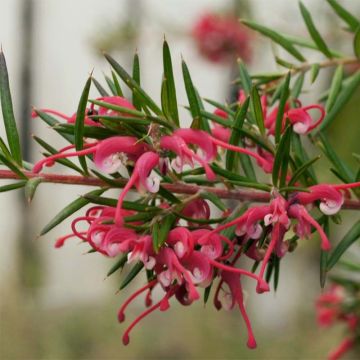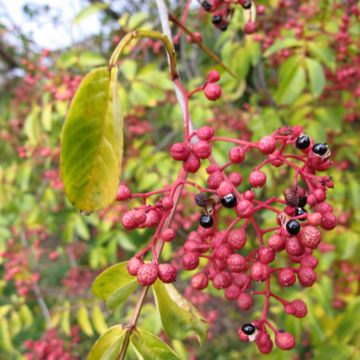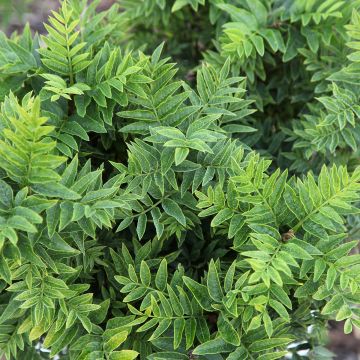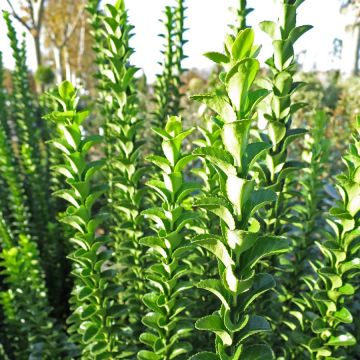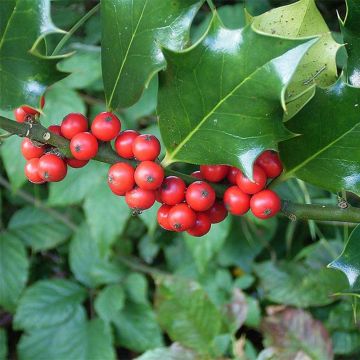

Catalpa bignonioides Variegata - Indian Bean Tree
Catalpa bignonioides Variegata - Indian Bean Tree
Catalpa bignonioides Variegata
Indian Bean Tree, Cigar Tree, Southern Catalpa
Why not try an alternative variety in stock?
View all →This plant carries a 24 months recovery warranty
More information
We guarantee the quality of our plants for a full growing cycle, and will replace at our expense any plant that fails to recover under normal climatic and planting conditions.
Oversize package: home delivery by special carrier from €6.90 per order..
Express home delivery from €8.90.
Does this plant fit my garden?
Set up your Plantfit profile →
Description
The Catalpa bignonioides 'Variegata' is a beautifully variegated form of the ornamental tree known as Catalpa. The usual green colour of its foliage is largely replaced by a border of light green to cream yellow. This lovely variegation is most prominent on the young leaves in spring and becomes greener with age. Smaller than the common Catalpa, it features the same beautiful heart-shaped leaves and produces lilac-white panicle flowers before its long, pendulous pods. It provides a dense and pleasant shade in a garden during summer. It prefers a semi-shaded exposure. Vigorous pruning every spring is spectacular on this variety, allowing for large and highly variegated leaves, at the expense of flowering.
The Catalpa bignonioides, also known as the Indian Bean Tree, is a deciduous tree from the Bignoniaceae family: a cousin to beautiful climbers like Campsis, Bignonia, Podranea, and Tecomaria. Native to the southeastern United States, it was introduced to Europe in 1726. It is a light-demanding species that appreciates moist soils, tolerates limestone, and is highly resistant to urban pollution. It exhibits rapid growth, dense and branching vegetation, and remarkably large leaves. At 10 years old, this tree reaches a height of 8 to 15 m and develops a wide crown of 10 to 15 m. Its bark is grey-brown and slightly channelled, peeling off over time in small patches. Its branches are brittle. Its foliage is deciduous, appearing late in spring and quickly falling in autumn. The leaves are elongated heart-shaped, medium green in spring and summer, turning yellow in autumn. In July, it bears beautiful clusters of white flowers, highly attractive to pollinating insects. These are followed by long pods, 20 to 50 cm in length, green and then brown when ripe. Its shallow root system does not tolerate drought. This Catalpa benefits from severe pruning every 2 or 3 years to maintain a dense habit.
The 'Variegata' cultivar is a smaller tree, slow-growing, reaching a height of 5 to 6 m and a width of 4 to 5 m at 10 years old. When the buds burst, the leaves are copper-purple in colour. They then turn green with a wide border of cream yellow or light green. Flowering occurs in May, at the tips of the branches. It takes the form of panicles filled with bell-shaped flowers with fringed edges. The outer part of the flowers is white-lilac, while the inside is golden yellow. The nectar-bearing flowers are pollinated by insects and produce hanging pods that resemble large beans.
The 'Variegata' Catalpa prefers a semi-shaded location to protect its foliage from the burning sun. Its shallow root system and brittle branches make it unable to withstand strong winds, so it should be planted in a sheltered position in medium to large gardens. Highly decorative and bright, it can be planted as a standalone specimen in a city garden. In a bed of large shrubs, it can be paired with other species with colourful foliage, such as Black Lace Elderberry or Royal Purple Smoke Bush. Some dry shade perennial plants can be planted at its base, as long as they have low water requirements, as its shallow roots absorb surface water.
Report an error about the product description
Plant habit
Flowering
Foliage
Botanical data
Catalpa
bignonioides
Variegata
Bignoniaceae
Indian Bean Tree, Cigar Tree, Southern Catalpa
Cultivar or hybrid
Other Catalpa
Planting and care
Plant your Catalpa bignonioides 'Variegata' in a semi-shaded position. Be careful not to plant it in a windy area, as its wood is brittle. It appreciates any type of soil as long as it is deep, and you provide good drainage; suffocating soils can cause the attack of wood-rotting fungi (such as honey fungus, a parasitic fungus that feeds on tree wood). The catalpa does not appreciate overly dry soils, and it is much more beautiful in fertile soils. After planting, water generously to eliminate air pockets. In case of drought, water for a few weeks to promote root growth.
The plant benefits from being pruned severely every 2 or 3 years to remain dense. It can be pruned into a central leader or coppice shoots, depending on the available space.
Planting period
Intended location
Care
This item has not been reviewed yet - be the first to leave a review about it.
Striking foliage shrubs
Haven't found what you were looking for?
Hardiness is the lowest winter temperature a plant can endure without suffering serious damage or even dying. However, hardiness is affected by location (a sheltered area, such as a patio), protection (winter cover) and soil type (hardiness is improved by well-drained soil).

Photo Sharing Terms & Conditions
In order to encourage gardeners to interact and share their experiences, Promesse de fleurs offers various media enabling content to be uploaded onto its Site - in particular via the ‘Photo sharing’ module.
The User agrees to refrain from:
- Posting any content that is illegal, prejudicial, insulting, racist, inciteful to hatred, revisionist, contrary to public decency, that infringes on privacy or on the privacy rights of third parties, in particular the publicity rights of persons and goods, intellectual property rights, or the right to privacy.
- Submitting content on behalf of a third party;
- Impersonate the identity of a third party and/or publish any personal information about a third party;
In general, the User undertakes to refrain from any unethical behaviour.
All Content (in particular text, comments, files, images, photos, videos, creative works, etc.), which may be subject to property or intellectual property rights, image or other private rights, shall remain the property of the User, subject to the limited rights granted by the terms of the licence granted by Promesse de fleurs as stated below. Users are at liberty to publish or not to publish such Content on the Site, notably via the ‘Photo Sharing’ facility, and accept that this Content shall be made public and freely accessible, notably on the Internet.
Users further acknowledge, undertake to have ,and guarantee that they hold all necessary rights and permissions to publish such material on the Site, in particular with regard to the legislation in force pertaining to any privacy, property, intellectual property, image, or contractual rights, or rights of any other nature. By publishing such Content on the Site, Users acknowledge accepting full liability as publishers of the Content within the meaning of the law, and grant Promesse de fleurs, free of charge, an inclusive, worldwide licence for the said Content for the entire duration of its publication, including all reproduction, representation, up/downloading, displaying, performing, transmission, and storage rights.
Users also grant permission for their name to be linked to the Content and accept that this link may not always be made available.
By engaging in posting material, Users consent to their Content becoming automatically accessible on the Internet, in particular on other sites and/or blogs and/or web pages of the Promesse de fleurs site, including in particular social pages and the Promesse de fleurs catalogue.
Users may secure the removal of entrusted content free of charge by issuing a simple request via our contact form.
The flowering period indicated on our website applies to countries and regions located in USDA zone 8 (France, the United Kingdom, Ireland, the Netherlands, etc.)
It will vary according to where you live:
- In zones 9 to 10 (Italy, Spain, Greece, etc.), flowering will occur about 2 to 4 weeks earlier.
- In zones 6 to 7 (Germany, Poland, Slovenia, and lower mountainous regions), flowering will be delayed by 2 to 3 weeks.
- In zone 5 (Central Europe, Scandinavia), blooming will be delayed by 3 to 5 weeks.
In temperate climates, pruning of spring-flowering shrubs (forsythia, spireas, etc.) should be done just after flowering.
Pruning of summer-flowering shrubs (Indian Lilac, Perovskia, etc.) can be done in winter or spring.
In cold regions as well as with frost-sensitive plants, avoid pruning too early when severe frosts may still occur.
The planting period indicated on our website applies to countries and regions located in USDA zone 8 (France, United Kingdom, Ireland, Netherlands).
It will vary according to where you live:
- In Mediterranean zones (Marseille, Madrid, Milan, etc.), autumn and winter are the best planting periods.
- In continental zones (Strasbourg, Munich, Vienna, etc.), delay planting by 2 to 3 weeks in spring and bring it forward by 2 to 4 weeks in autumn.
- In mountainous regions (the Alps, Pyrenees, Carpathians, etc.), it is best to plant in late spring (May-June) or late summer (August-September).
The harvesting period indicated on our website applies to countries and regions in USDA zone 8 (France, England, Ireland, the Netherlands).
In colder areas (Scandinavia, Poland, Austria...) fruit and vegetable harvests are likely to be delayed by 3-4 weeks.
In warmer areas (Italy, Spain, Greece, etc.), harvesting will probably take place earlier, depending on weather conditions.
The sowing periods indicated on our website apply to countries and regions within USDA Zone 8 (France, UK, Ireland, Netherlands).
In colder areas (Scandinavia, Poland, Austria...), delay any outdoor sowing by 3-4 weeks, or sow under glass.
In warmer climes (Italy, Spain, Greece, etc.), bring outdoor sowing forward by a few weeks.









































